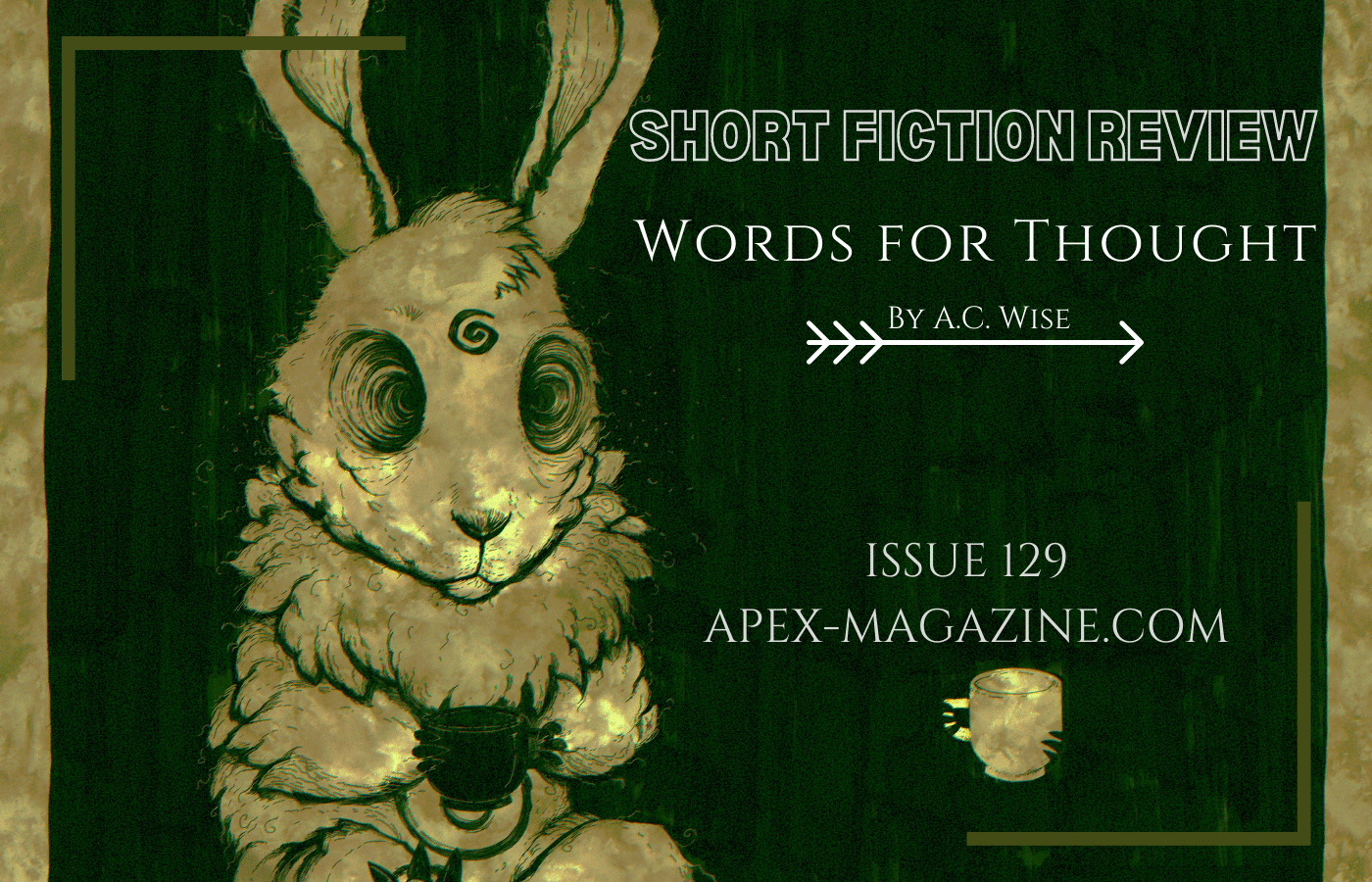
Welcome to the first Words for Thought of the New Year! Even though the calendar has flipped over, it still feels a bit like we’re stuck in a holding pattern, doesn’t it? Things progress, and then they backslide. Time feels a bit wonky. I haven’t fully wrapped my head around 2021 even having started, let alone it being over. But all that said, fiction remains a bright spot—even, and perhaps especially, dark fiction. At its best, horror and dark fiction acts as a catharsis, a way to process emotion and speak about the unspeakable. Each of the stories discussed here does this in its own way. Some offer hope and others let you know that even if it doesn’t seem like a comforting thought, remaining in the dark is okay because you’re not in it alone.
§
Missing Dolls Around the World by Ai Jiang in The Dark is a short, but powerful piece that uses the imagery of dolls buried in coffins to stand in for missing and murdered people who have had their humanity stripped away to become mere objects of curiosity.
Within the coffin lay a molding doll dressed in plain black cotton smeared with specks of dirt and one eye missing. Where there should have been a black, plastic void, there was instead a deep speckled green that spread across the rubber face like disease.
Within a short space of words, the story touches on various forms of erasure—the violent cultural assimilation of the schools Indigenous children have been forced into throughout history, wives who have their power and voices taken away by their husbands, and people who have to suppress their true selves to try to survive. It isn’t an easy story or a comfortable one, but it forces us to confront the unseen and acknowledge and remember the individuals who were forced from the world employing violence. Jiang’s imagery is unsettling, and the story creeps slowly from the metaphorical to laying bare the very real-world horrors it describes, underlining the point that we can’t allow acts of violence and erasure like these to stay buried and hidden.
§
Vampirito by K. Victoria Hernandez in Khōréō Magazine uses the metaphor of vampirism to explore the idea around the fear of the unknown and othering, particularly when it comes to the children of immigrant families and the question of which world outsiders see them belonging to and where they see themselves belonging.
Everybody knows that a true vampire, though possessed of many traits, is critically defined by three:
1. Is afraid of the sun.
2. Has really, really long fangs.
3. Thirsts for human blood.
Eli was a true—one hundred percent, without a doubt—vampire, and had none of the traits above.
Eli is a young vampire who doesn't particularly fit the mold of what a vampire is supposed to be. The other kids in the neighborhood bully him, demanding he proves himself by showing his fangs or doing the things everybody knows vampires do. He simultaneously feels too much like a vampire and not enough like a vampire, complicated by his grandfather's feelings towards his father, the differing traditions within the different sides of his family, and the way his parents try to protect him and get along, versus his grandfather's anger at and disdain for humans.
The story is lovely and occasionally heartbreaking as it touches on themes of prejudice, stereotypes, and the question of authenticity and who gets to define what is authentic. At the same time, the story offers hope. In the end, it is down to Eli to define himself, to recognize the various pieces that make him up are one part of the equation, but that ultimately what he does with those pieces is his choice alone.
§
The Genius and the Devil by Stephanie Feldman in Catapult Magazine makes the classic deal-with-the-devil story the backdrop for exploring friendship, art, and the nebulous idea of “genius.”
My mind climbed and rolled along the black lines, following the path the Genius prescribed. I saw her singular sense of balance: the blackness and the whiteness, the thickness and the thinness, the angles and the curves. What is foreground? What is background? Why does that frayed stroke touch a frayed place within me? Why does that deep black make my envy simmer?
The Genius is dying and asks the protagonist, her childhood friend, to do her one last favor—watch over her corpse so the Devil can’t take her soul. There’s something appropriate to the times about the idea of a long, dark, and lonely vigil amid a storm, watching and defending against the unknown. The Devil comes in various guises and offers various temptations, as devils do, but the heart of the story is Feldman’s exploration of friendship—what we owe to those who were once the closest people to us even as our lives diverge—and the idea of genius itself.
Who is considered a genius? What does it mean to be a genius? And perhaps most importantly, what impact does being given the space to be a genius have? Could we all be geniuses if we didn’t have to deal with the mundanities of life, if we didn’t feel we owed anyone else our time and we could hoard it all for our own and spend it however we wanted? Is genius inherently selfish? The story also explores where the value of art lies—must it touch others or can it be meaningful only to the artist? They are interesting questions to consider—what and who we value, and how that value is conveyed and conferred. All of that and the story itself is satisfying as well, smoothly-written with striking imagery, holding onto the humanity at its core even as it explores big-picture questions.
§
That Story Isn’t the Story by John Wiswell in Uncanny Magazine is a novelette that, like Hernandez’s story, uses vampirism as a metaphor to explore the darker aspects of humanity—in this case, recovery from trauma and abuse. Anton is one of several familiars kept by the vampire Mr. Bird. With the help of his childhood friend, Grigorii, Anton makes his escape from Mr. Bird’s house, but leaving isn’t as easy as walking out the door.
He heads for the stairs that will lead him out of the townhouse. It’ll be the first time he’s gone outside in so long it feels like he’s never been outside. Time outside the gothic damask flock wallpaper and blacked out windows still doesn’t seem real.
Mr. Bird has convinced his familiars they can’t live without him. He has shown them there will be consequences for their action—they will bleed when he is angry with them—and he has convinced them that there is nowhere they can go they will be safe. He warns them there will be retribution, and Anton is afraid of putting his new-found family of Grigorii and his roommate, Luis, in danger.
It’s heartbreaking and provides an all-too-real look at the way abusers make their victims feel powerless, isolate them, make them doubt their worth, make them feel that their pain is their fault. At the same time, like “Vampirito,” Wiswell’s story offers hope. Anton’s found family is a powerful force in his recovery, as is the idea of choice. The title of the story is a refrain running through it—Anton can choose his narrative, choose the story he wants to tell going forward, no matter what came before. Like Hernandez’s Eli, Wiswell’s Anton will always contain the pieces and influences that brought him to this point in his life, but what to do with them going forward, how he wants to assemble them to inform his identity, is entirely up to him.
§
That House by Simon Strantzas in Bourbon Penn takes on the trope of the haunted house and uses it as Wiswell uses vampires to explore tragedy, trauma, and recovery.
There is a house in Newton, down Oak Lane, that’s been vacant almost twenty years. Its slanted wooden shutters have been nailed closed and its cracked windows boarded over so it looks like a face without eyes or a mouth. Marta and I drove past it only once, and only by accident, on our way to the hospital while Marta sobbed and bled and told me it felt like a shard of jagged glass was sliding into her stomach.
After his wife miscarries, a novelist becomes obsessed with an abandoned house in his neighborhood, using it as the focal point for his grief and a convenient place to lay blame. Strantzas does an excellent job of blurring reality and fiction and providing meta commentary on narrative and the way we use it to make sense of our lives and give meaning to the events in them.
Circling back to the opening of this column, how horror fiction, in particular, is used to express cultural fears or process personal emotions is touched on within this story as the narrator both lives his horror and comments on it from the outside. What is the purpose of a haunted house? Is the house the source of the author and his wife’s grief, or has their grief itself become a haunting? Once loss and grief have manifested in the world as a haunting, do they become an external reality, does the haunting, in essence, become “real”? The writing is effective and unsettling, the blurring between the personal haunting and the idea of the truly supernatural is well done, and there is a real sense of dread and unease permeating the story that makes it a satisfying piece of horror fiction on multiple levels.










